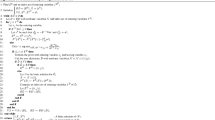Abstract
We will show that the average number of steps of parametric simplex algorithms for obtaining global minima of rank-one and rank-two bilinear-programming problems are lower-order polynomial functions of the problem size under the standard assumptions on the distribution of the data imposed in the probabilistic analysis of the simplex method. This means that there exist algorithms for some special class of NP-complete problems, whose average number of arithmetics are polynomial order of the problem size.
Similar content being viewed by others
References
I. Adler, “The expected number of pivots needed to solve parametric linear programs and the efficiency of the self-dual simplex method”, Department of IEOR, University of California, Berkeley, CA, Tech. Report, 1983.
I. Adler, R. Karp, and R. Shamir, “A family of simplex variants solving an m×d linear program in expected number of pivot steps depending on d only”, Math. of Oper. Res., vol. 11, 570–590, 1986.
I. Adler and N. Megiddo, “A simplex algorithm whose average number of steps is bounded between two quadratic functions of the smaller dimension”, J. of the ACM, vol. 32, 871–895, 1985.
K.H. Borgwardt, The Simplex Methods: A Probabilistic Analysis, Springer-Verlag: 1982.
V. Chvátal, Linear Programming W.H. Freeman and Company: New York, NY, 1983.
S.I. Gass and E.L. Saaty, “The computational algorithm for the parametric objective function”, Nav. Res. Logistics Q., vol. 2, pp. 39–45, 1955.
M. Haimovich, “The simplex algorithm is very good!! — on the expected number of pivot steps and related properties of random linear programs (draft)”, Uris Hall, Columbia University, New York, NY, Tech. Report, 1983.
R.M. Karp and J.M. Steele, “Probabilistic analysis of heuristics”, in The Traveling Salesman Problem, (E.L. Lawler, et al., eds.), John Wiley and Sons: New York, NY, 1985.
L.G. Khachian, “A polynomial algorithm for linear programming”, Dokla. Akad. Nauk. USSR, vol. 244, 1093–1096, 1979.
H. Konno, “Computational complexity of the linear multiplicative programming problem”, Institute of Human and Social Sciences, Tokyo Institute of Technology, Tokyo, IHSS Report 91-37, 1991.
H. Konno and Y. Yajima, “Solving rank two bilinear programs by parametric simplex algorithms”, Institute of Human and Social Sciences, Tokyo Institute of Technology, Tokyo, IHSS Report 90-17,
H. Konno, Y. Yajima, and T. Matsui, “Parametric simplex algorithm for solving special class of nonconvex minimization problems”, J. of Global Optimization, vol. 1, 65–81, 1991.
J.K. Lenstra and A.H.G. Rinnooy Kan, “On the expected performance of Branch-and-bound algorithm”, Oper. Res., vol. 26, 347–349, 1978.
N. Megiddo, “On the expected number of linear complementary cones intersected by random and semi-random rays”, Math. Programming, vol. 35, 225–235, 1986.
K.G. Murty, “Computational complexity of parametric linear programming”, Math. Programming, vol. 19, 213–219, 1980.
P.M. Pardalos, “Polynomial time algorithms for some classes of constrained nonconvex quadratic problems”, Optimization, vol. 21, 483–853, 1990.
P.M. Pardalos, “Global optimization algorithms for linear constrained indefinite quadratic problems”, Computers Math. Appl., vol. 21, 87–97, 1991.
P.M. Pardalos and S.A. Vavasis, “Quadratic programming with one negative eigenvalue is NP-hard”, J. of Global Optimization, vol. 1, 15–22, 1991.
A. Schrijver, Theory of Linear and Integer Programming, John-Wiley & Sons: New York, NY, 1986.
R. Shamir, “The efficiency of the simplex method: a survey”, Management Sci. vol. 33, 301–334, 1987.
S. Smale, “On the average speed of the simplex method of linear programming”, Math. Programming, vol. 27, 241–262, 1983.
M.J. Todd, “Polynomial expected behavior of a pivoting algorithm for linear complementarity and linear programming problems”, Math. Programming, vol. 35, 173–192, 1986.
S.A. Vavasis, “Quadratic programming is in NP”, Information Processing Letters, vol. 36, 73–77, 1990.
Y. Yajima and H. Konno, “Efficient algorithms for solving rank two and rank three bilinear programming problems”, Global Optimization, vol. 1, 155–171, 1990.
Author information
Authors and Affiliations
Rights and permissions
About this article
Cite this article
Konno, H., Kuno, T. & Yajima, Y. Parametric simplex algorithms for a class of NP-Complete problems whose average number of steps is polynomial. Comput Optim Applic 1, 227–239 (1992). https://doi.org/10.1007/BF00253808
Received:
Revised:
Issue Date:
DOI: https://doi.org/10.1007/BF00253808




